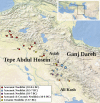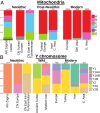Herded and hunted goat genomes from the dawn of domestication in the Zagros Mountains
- PMID: 34099576
- PMCID: PMC8237664
- DOI: 10.1073/pnas.2100901118
Herded and hunted goat genomes from the dawn of domestication in the Zagros Mountains
Abstract
The Aceramic Neolithic (∼9600 to 7000 cal BC) period in the Zagros Mountains, western Iran, provides some of the earliest archaeological evidence of goat (Capra hircus) management and husbandry by circa 8200 cal BC, with detectable morphological change appearing ∼1,000 y later. To examine the genomic imprint of initial management and its implications for the goat domestication process, we analyzed 14 novel nuclear genomes (mean coverage 1.13X) and 32 mitochondrial (mtDNA) genomes (mean coverage 143X) from two such sites, Ganj Dareh and Tepe Abdul Hosein. These genomes show two distinct clusters: those with domestic affinity and a minority group with stronger wild affinity, indicating that managed goats were genetically distinct from wild goats at this early horizon. This genetic duality, the presence of long runs of homozygosity, shared ancestry with later Neolithic populations, a sex bias in archaeozoological remains, and demographic profiles from across all layers of Ganj Dareh support management of genetically domestic goat by circa 8200 cal BC, and represent the oldest to-this-date reported livestock genomes. In these sites a combination of high autosomal and mtDNA diversity, contrasting limited Y chromosomal lineage diversity, an absence of reported selection signatures for pigmentation, and the wild morphology of bone remains illustrates domestication as an extended process lacking a strong initial bottleneck, beginning with spatial control, demographic manipulation via biased male culling, captive breeding, and subsequently phenotypic and genomic selection.
Keywords: Neolithic; ancient DNA; archaeozoology; caprine; domestication.
Copyright © 2021 the Author(s). Published by PNAS.
Conflict of interest statement
The authors declare no competing interest.
Figures







References
-
- Ibáñez J. J., González-Urquijo J., Teira-Mayolini L. C., Lazuén T., The emergence of the Neolithic in the Near East: A protracted and multi-regional model. Quat. Int. 470, 226–252 (2018).
-
- Bar-Yosef O., Meadow R. H., “The origins of agriculture in the Near East” in Last Hunters, First Farmers: New Perspectives on the Prehistoric Transition to Agriculture, Price T. D., Gebauer A.-B., Eds. (School of American Research Press, 1995), pp. 39–94.
-
- Kozłowski S. K., Aurenche O., Territories, Boundaries and Cultures in the Neolithic Near East (BAR, 2005).
-
- Roustaei K., Mashkour M., “Foreword” in The Neolithic of the Iranian Plateau: Recent Research and Prospects, SENEPSE., Roustaei K., Mashkour M., Eds. (Ex Oriente, 2016), pp. i–vii.
Publication types
MeSH terms
Substances
LinkOut - more resources
Full Text Sources

